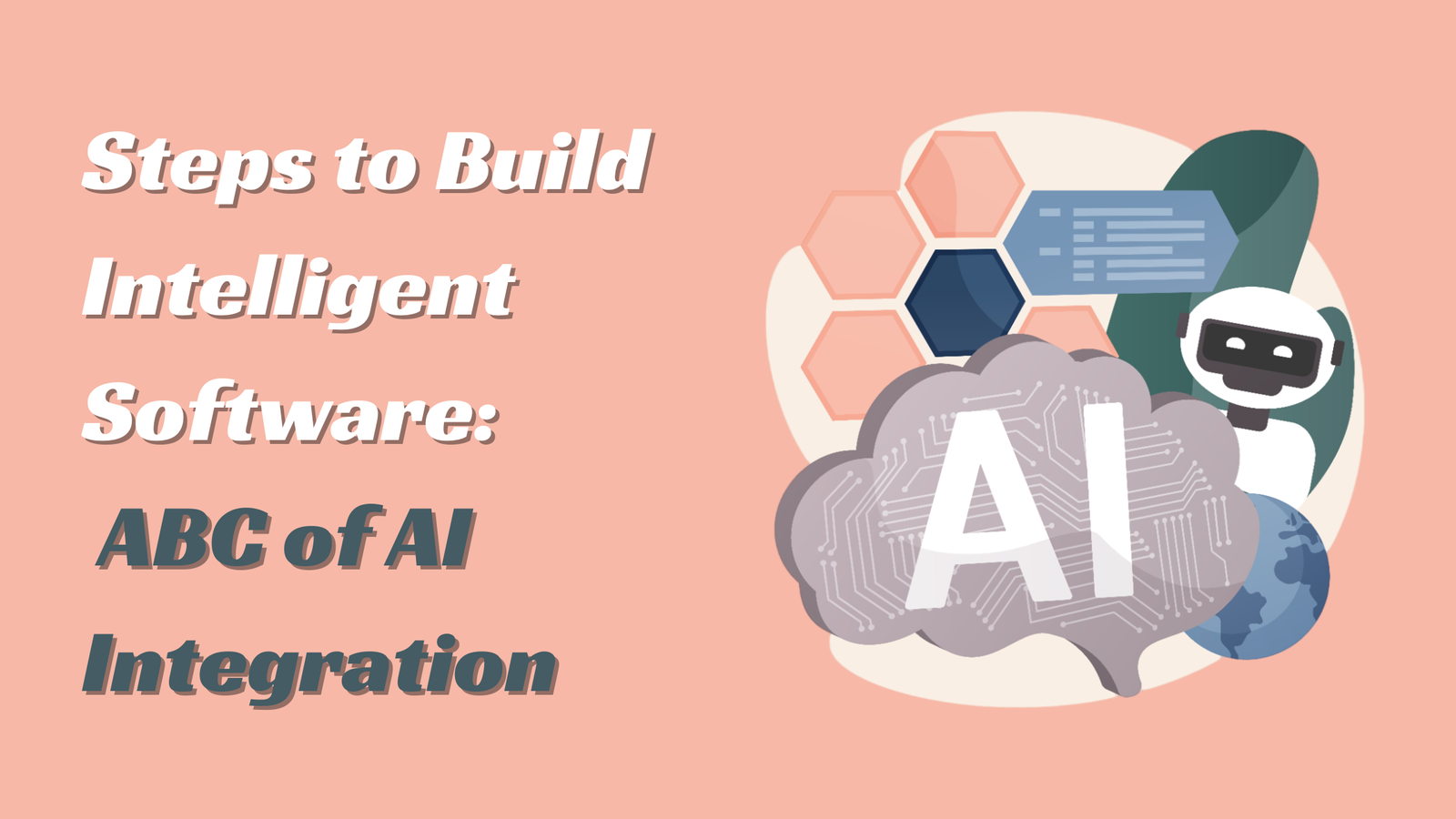Steps to Build Intelligent Software: ABC of AI Integration
- 1 Why AI? The Irresistible Lure
- 2 Getting Started with AI Software Development
- 3 Real-World Integration of Artificial Intelligence Solutions
- 3.1 Healthcare Diagnostics
- 3.2 Financial Fraud Detection
- 3.3 Smart Home Devices
- 3.4 Automotive Safety
- 3.5 Supply Chain Optimization
- 4 Overcoming Challenges in AI Implementation
- 5 Conclusion: Your AI Journey Awaits
“I want to integrate AI in my enterprise software; help me with it!” a friend said over a pickleball match. I asked, “Why do you need AI?” He said, “Why not? The world is implementing AI; I want it, too.” My team undoubtedly helped him integrate AI successfully into his business software. But this conversation made me realize how people are willing to get on with AI just because of the trend and not because of its benefits to the organization.
I am Chandresh, Founder and CEO of Bacancy Technology, an IT firm based in India. I am writing this blog to inform my fellow business leaders that you shouldn’t integrate AI just because the world is doing it. You should identify the importance and reasons for implementing AI solutions in your organization. If it adds value, go with AI integration, and if it’s not returning as much as you invested, you should try something else.
But you might wonder, “How will I know if integrating AI solutions will benefit my business?” Let me break down the points for you and then explore the essential steps to building intelligent software for your organization.
Why AI? The Irresistible Lure
Who wouldn’t wish for software that not only does what it’s told to do but also thinks for itself and recommends the better solution to your query or action? Integrating AI into software is about enhancing its capabilities. AI is your go-to tech for productivity power-ups, from automating repetitive tasks to accelerating complex decision-making processes. Most importantly, AI doesn’t ask for coffee breaks, vacations, or yearly hikes. I am not against giving these to our human employees. But if there are tasks that can allow my employees to enjoy some leisure time, why wouldn’t I let them have it?
Getting Started with AI Software Development
You must be curious about making your software think and perform independently. Let’s start with the focus of this blog, which brought you here: “Steps to Build Intelligent Software.”
Here are the steps to get started with AI software development:
- Define Your AI Goals: Start by pinpointing precisely what AI features you need in your software. Are you looking to streamline operations, enhance user interactions, or predict user behavior? Your goals will determine the AI tools and approach you take.
- Gather Your Data: Structured or unstructured, without Data, AI can’t proceed. Try to collect and clean relevant data from which Artificial Intelligence can learn. More data is good if the quality and relevance match.
- Choose the Right AI Model: Whether it’s Machine Learning, Deep Learning, or Neural Networks, select an AI model that best fits your requirements.
- Pick the Right Tools and Platforms: Each AI platform and tool has unique features. Choose AI tools that align with your technical capabilities and project requirements, from TensorFlow and PyTorch to Azure ML and Google AI.
- Develop a Prototype: Start small with a prototype to test the feasibility of your AI implementation. This approach allows you to gauge effectiveness and iterate quickly before a full-scale rollout.
- Ensure Ethical AI Use: Ensure your AI systems are fair, transparent, and privacy-conscious, safeguarding user data. Ethical considerations are of utmost importance when dealing with data.
- Plan for AI Training and Testing: Regularly train your AI model with diverse datasets to avoid biases and adapt to new data to improve accuracy.
- Prepare for Integration and Scaling: Make sure your infrastructure supports Artificial Intelligence. If not, moving to more robust server solutions or considering cloud environments to handle increased data processing demands would be recommended.
- Stay Informed on AI Trends: AI technologies evolve at the speed of an ice cube melting outside the fridge. So, staying updated with the latest developments can enhance your software and might open doors for unexpected growth.
- Seek Expert Advice: If you are new to this or have some skills in Artificial Intelligence, you don’t need to worry. We offer AI consultation and can help you customize AI strategies to meet your objectives.
- Educate Your Team: If your team is new to leveraging AI tools to their full potential, consider training them to boost their skills, as this will ultimately benefit your organization.
- Monitor and Optimize: Once AI is integrated successfully, monitor its impact on your process. Leverage analytics to optimize processes and improve user experience.
- Get Feedback: Take feedback from the employees working on the AI software and the stakeholders to understand how well AI meets the organization’s objectives. Make informed decisions by gathering input from the team.
These steps will help you build intelligent software solutions that enhance functionality and user satisfaction. For more detailed information, you can look at our AI software development services, which will also inform you about our capabilities as a company.
Real-World Integration of Artificial Intelligence Solutions
To boost your confidence even more, I have mentioned some of the case studies for which my company has worked and benefited our clients tremendously.
Healthcare Diagnostics
As the CEO of a leading AI-enabled software development company, I’ve witnessed firsthand the transformative impact of AI in healthcare diagnostics. By integrating advanced AI algorithms into diagnostic software, we empowered healthcare providers to detect diseases early and accurately, leading to better patient outcomes.
Our AI-driven tools analyze medical images, such as X-rays and MRIs, with remarkable precision, often identifying subtleties that escape the human eye.
Healthcare organizations can leverage these capabilities by partnering with us to enhance their diagnostic services, ultimately improving patient care and operational efficiency.
Financial Fraud Detection
The stakes are incredibly high in financial organizations, and the cost of fraud can be devastating. I am proud that our AI solutions have been instrumental in detecting and preventing financial fraud for the UK’s leading Financial institution.
Our systems use machine learning models to analyze transaction patterns and flag anomalies in real-time, reducing false positives and helping financial institutions respond swiftly to potential threats.
By adopting AI in fraud detection, businesses can safeguard their assets and maintain trust with their customers, ensuring a secure financial environment.
Smart Home Devices
The smart home industry is booming, and AI is at the heart of this revolution. Integrating AI into smart home devices enhances user convenience and improves energy efficiency and security for our valued clients in the USA.
Our AI algorithms can learn from user behaviors to automate home systems, such as lighting, heating, and security, creating a personalized experience.
For companies in this space, working with us means staying at the forefront of innovation, offering customers cutting-edge solutions that make their homes smarter and their lives easier.
Automotive Safety
Safety is paramount in the Automotive industry. Our AI-driven solutions focus on enhancing vehicle safety through advanced driver-assistance systems (ADAS) for a big car manufacturing company in the USA. These systems perfectly utilized AI in automotive to interpret sensor data, anticipate potential hazards, and take preemptive actions to avoid accidents.
I assure you that by integrating our AI technology, automotive manufacturers can significantly reduce the risk of accidents and enhance the overall safety of their vehicles. This saves lives and positions our partners as leaders in automotive innovation.
Supply Chain Optimization
Optimizing supply chain operations is crucial for maintaining efficiency and meeting consumer demands. Interacting with clients and my team, I’ve seen how AI can transform supply chain management by predicting market trends, optimizing inventory levels, and identifying the most efficient delivery routes.
Our AI solutions provide real-time insights and predictive analytics, helping businesses stay agile and competitive. By collaborating with us, companies can ensure that their supply chain is responsive and a strategic asset in their business model.
Look at this collection of AI/ML blogs to see the capabilities of this technology in your industry. However, we must not overlook the challenges of implementing AI by focusing only on the benefits.
Overcoming Challenges in AI Implementation
Artificial Intelligence sounds good, but it’s not without hiccups. Data quality can vary, and choosing a suitable AI model can be trickier. So many other challenges are not quite visible to business leaders who are leveraging these technologies just for the sake of trend. But here’s the good news: these challenges can be resolved with the right approach.
Data Quality and Quantity: The success of AI Integration largely depends on the quality and quantity of data available. Poor data can lead to inaccurate models and unreliable outcomes.
- Solution: Invest in robust data collection and cleaning processes. Utilize advanced data analytics to ensure your data is accurate, relevant, and sufficiently voluminous.
Integration Complexity: Some businesses might find Integrating AI into existing systems as they could use outdated infrastructure.
- Solution: Start with a feasibility study to assess your current systems’ compatibility with AI technologies. Consider gradual integration strategies or updating critical parts of your infrastructure.
Skill Gaps: Your team may have skill gaps regarding AI technologies, which can hinder effective implementation.
- Solution: Invest in training and development for your current workforce. Alternatively, hire or collaborate with AI specialists who can bridge the gap.
Ethical and Privacy Concerns: AI implementations can raise ethical issues, particularly related to privacy, bias, and transparency.
- Solution: Develop a clear ethical AI framework and conduct regular audits for compliance. Ensure transparency in how AI processes data and make efforts to mitigate biases by training models on diverse data sets.
High Costs and Resource Intensive: AI’s initial setup and ongoing operation can be costly and resource-intensive.
- Solution: Plan a phased investment strategy, starting with pilot projects to demonstrate ROI before full-scale implementation. Utilize cloud-based AI services to reduce upfront costs.
Maintaining AI Systems: To stay effective, AI systems require continuous monitoring, maintenance, and training, which can be resource-intensive.
- Solution: Implement automated monitoring tools and set up regular maintenance schedules. Continuously collect new data to retrain and refine AI models.
Regulatory Compliance: Navigating the evolving landscape of regulations concerning AI can be challenging.
- Solution: Stay updated with AI regulations and involve legal experts during the planning and implementation phases to ensure compliance.
Expectation Management: There is often a mismatch between stakeholder expectations and what AI can realistically achieve.
- Solution: Set achievable goals and communicate regularly with stakeholders about AI capabilities and limitations. Manage expectations through education and transparent reporting.
By addressing these challenges head-on with strategic planning and following the steps we discussed above, you can increase your chances of building intelligent software for your organization, which will lead to long-term benefits.
Conclusion: Your AI Journey Awaits
Think of AI as a tangible tool, not a robot from the movie, and let’s face the fact that businesses are embracing it, and it will stay in the market forever. You can build intelligent software by following the steps mentioned in this blog.
Give your enterprise software the wings it deserves! If you need a hand or want to avoid getting stuck in processes and compliances, contact my team for AI consulting services, and let’s team up to get started with your AI journey.

















